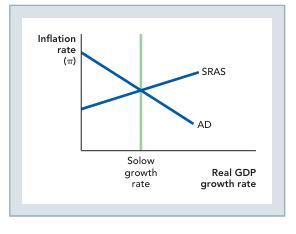We usually think about crowding out as a decrease in private consumption or investment in response to
Question:
We usually think about crowding out as a decrease in private consumption or investment in response to an increase in government purchases. But the idea works in reverse as well, an idea we might call “crowding in.” Consider the economy below. mk6

a. Starting from this initial position, the economy is hit by one shock: a large decrease in government purchases, perhaps caused by the end of a war. Holding the growth of C, I, and NX constant for a moment, illustrate this shock above, labeling the change “Fall in growth of G.”
b. Now consider a possible side effect of the fall in the growth of G: the reversal of crowding out or crowding in. If there is 100%
crowding in, what happens to the AD shift you described in part a?
c. If there were 100% crowding out/in and no multiplier effect, what can we say about the effect of a change in the growth of G on aggregate demand?
d. Consider all of the laid-off government workers in this question: If there were 100%
crowding out/in and no multiplier effect, where do these laid-off workers end up?
Step by Step Answer:






